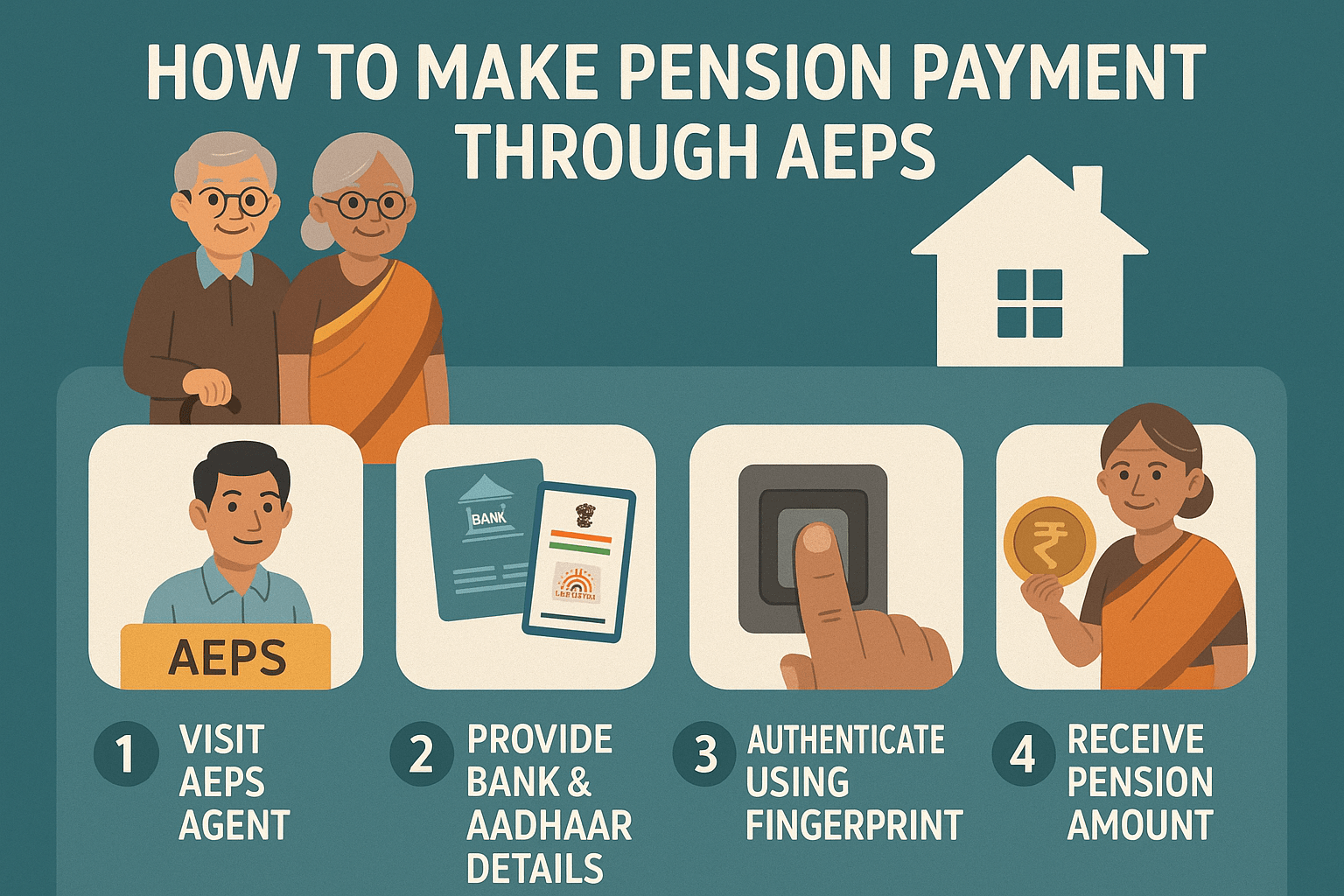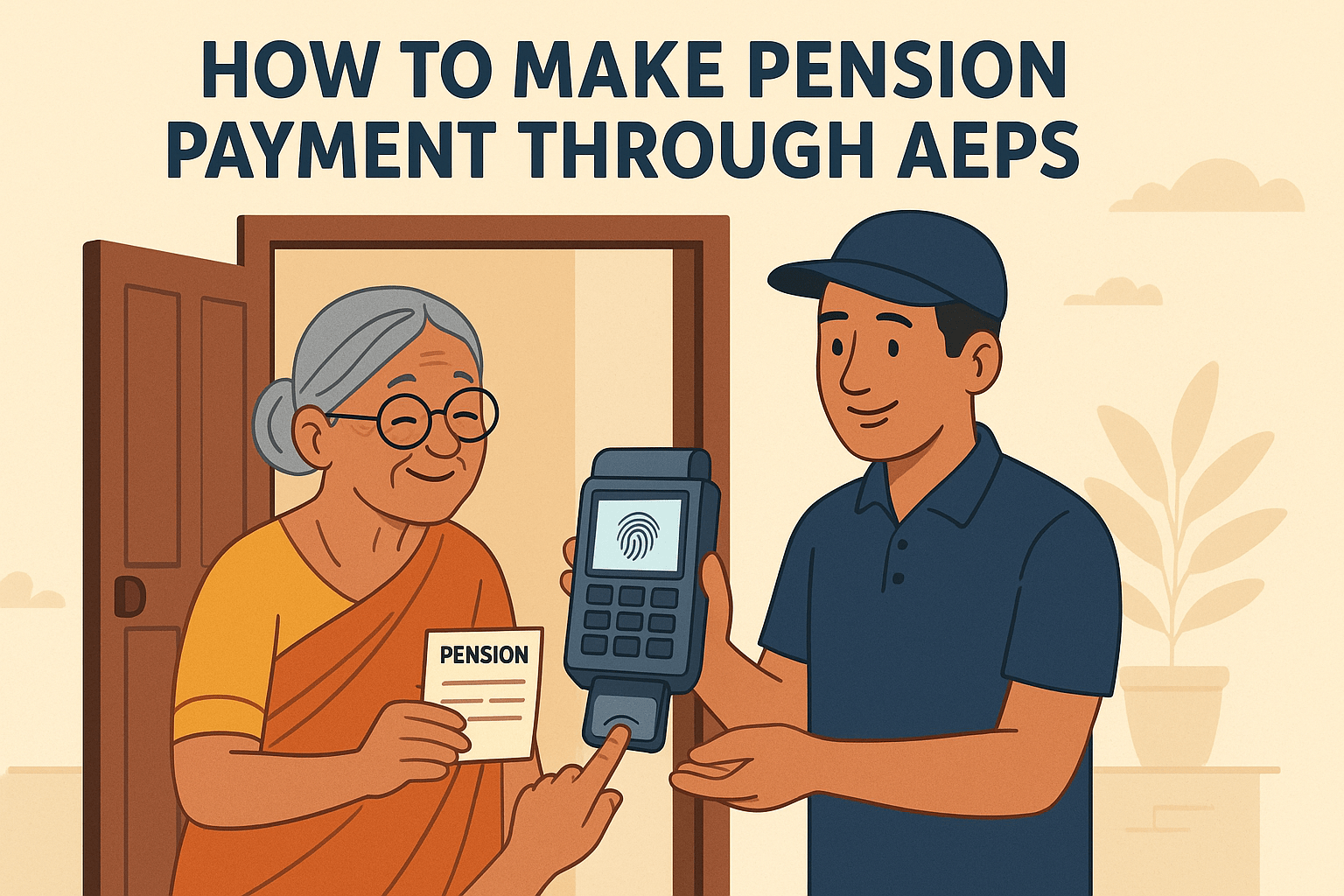For millions of senior citizens across India, the monthly pension is a (How to Make Pension Payment Through AEPS) crucial financial lifeline. Traditionally, collecting this pension meant long queues at banks, navigating complex paperwork, and often relying on others for transportation. But what if this essential service could come to your doorstep, requiring nothing more than your fingerprint? This is the revolutionary promise of the Aadhaar Enabled Payment System (AEPS). This comprehensive guide will walk you through exactly how to make pension payment through AEPS, transforming a once-tedious task into a simple, secure, and swift process.
What is AEPS and How Does It Relate to Pensions?
Before we dive into the “how,” let’s understand the “what.” The Aadhaar Enabled Payment System (AEPS) is a bank-led model that allows you to perform basic banking transactions at a Micro-ATM (a handheld device) by authenticating yourself with your Aadhaar number and fingerprint.
The Government of India, through various pension schemes like the National Social Assistance Programme (NSAP) which includes the Indira Gandhi National Old Age Pension Scheme (IGNOAPS), has integrated AEPS to disburse pensions directly to beneficiaries. This initiative is a cornerstone of the Direct Benefit Transfer (DBT) scheme, aimed at increasing transparency, reducing leakage, and ensuring funds reach the intended recipient directly.
In simple terms, AEPS cuts out the middleman. The pension amount is credited directly to your bank account, and you can withdraw it without a debit card or remembering a complex PIN—just your Aadhaar number and your biometrics.
Prerequisites for Receiving Pension via AEPS
To successfully receive your pension through an AEPS transaction, you must ensure the following are in place:
-
Aadhaar Number: You must be enrolled for Aadhaar and have a valid number.
-
Aadhaar-Linked Bank Account: Your pension account (where the DBT is credited) must be linked with your Aadhaar number. This is mandatory under the DBT scheme.
-
Aadhaar-Bank Account Mapping: Simply having an Aadhaar number and a bank account isn’t enough. They must be officially linked or “seeded.” You can verify this by:
-
Visiting your bank branch.
-
Using an ATM of your bank.
-
Checking online through your bank’s net banking portal.
-
Using the UIDAI’s website (https://myaadhaar.uidai.gov.in/).
-
-
Biometric Authentication: Your fingerprint (or iris) details must be correctly updated and viable in the UIDAI database. If your fingerprints are worn out, you should visit an Aadhaar Enrolment Centre to update them.

A Step-by-Step Guide: How to Make Pension Payment Through AEPS
The process for a pensioner to withdraw their money is straightforward. Here’s how it works:
Step 1: Locate a Banking Correspondent (BC) or CSP
Banking Correspondents (BCs), also known as Customer Service Points (CSPs), are authorized individuals or entities appointed by banks to provide doorstep banking services. They are typically located in common service centres, local kirana stores, or post offices equipped with a Micro-ATM. Your local bank branch can guide you to the nearest BC.
Step 2: Provide Your Aadhaar Number
Inform the BC agent that you wish to withdraw your pension. They will ask for your 12-digit Aadhaar number. The agent will enter this number into the Micro-ATM device.
Step 3: Select the Bank Name
You will need to tell the agent the name of the bank where your pension account is held. The agent will select it from a list on the Micro-ATM screen.
Step 4: Authenticate with Biometrics
This is the core security step. You will be asked to place your finger on the fingerprint scanner attached to the Micro-ATM. The device will verify your identity against the data stored with UIDAI.
Step 5: Choose the Transaction Type
The agent will select the transaction type—in this case, “Cash Withdrawal” or a specific “Pension” option if available.
Step 6: Collect Your Cash and Receipt
Once your fingerprint is verified, the transaction is authorized. The BC agent will dispense the cash amount equivalent to your pension. Always insist on receiving a printed transaction receipt. This receipt is your proof of payment and will contain details like:
-
Transaction ID
-
Date and Time
-
Amount withdrawn
-
Your bank account balance
This entire process is designed to be completed in a matter of minutes.
The Powerful Benefits of Using AEPS for Pension
-
Accessibility: Brings banking services to remote and rural areas where bank branches are scarce. Pensioners no longer need to travel long distances.
-
Simplicity: No need to remember bank account numbers or PINs. The process is intuitive and easy for everyone, regardless of literacy.
-
Security: Biometric authentication (fingerprint) ensures that only the genuine beneficiary can withdraw the money, drastically reducing fraud and identity theft.
-
Transparency: The direct transfer into the bank account, coupled with an immediate receipt, creates a clear audit trail, minimizing corruption and ensuring the full amount is received.
-
Dignity: Empowers senior citizens by giving them direct control over their finances without depending on family members or intermediaries.

Troubleshooting Common Issues
Even with a robust system, you might face occasional hiccups. Here’s what to do:
-
Biometric Authentication Failure: This is the most common issue, often caused by worn-out fingerprints, sweaty fingers, or a dirty scanner. Solution: Clean your finger and the scanner. Try a different finger (thumb usually works best). If it persistently fails, visit an Aadhaar Enrolment Centre to update your biometrics.
-
Aadhaar Not Linked to Bank Account: The transaction will be declined. Solution: Visit your bank branch immediately to complete the linking process.
-
Incorrect Balance Shown: The Micro-ATM might sometimes show an old balance if it can’t connect to the bank’s server in real-time. Solution: Ask the BC to retry the transaction or check your balance via a missed call or SMS banking service if registered.
-
BC Agent Not Available: Solution: Contact your bank’s toll-free number or branch manager to report the issue and find an alternative BC point.
The Bigger Picture: AEPS and Financial Inclusion
The use of AEPS for pension disbursement is more than just a convenience; it’s a critical tool for financial inclusion. According to a report by the World Bank, DBT through Aadhaar has saved the Indian government over ₹2.23 lakh crore by eliminating fake and duplicate beneficiaries. This massive saving translates into more efficient welfare systems and ensures that funds reach those who need them the most.
By simplifying the process, AEPS is bringing a vast segment of the population, often the elderly and the vulnerable, into the formal digital economy, empowering them and restoring their financial independence.
Frequently Asked Questions (FAQs)
1. Is there any transaction charge for withdrawing my pension via AEPS?
No. The government has mandated that AEPS transactions for DBT purposes, including pension withdrawal, are free of cost. The BC should not charge you any fee for this service.
2. What if I don’t have a bank account?
Having a bank account is a prerequisite for receiving DBT. If you don’t have one, you should open a basic savings bank account, preferably at a bank where you have easy access to a branch or a BC point. You will then need to seed your Aadhaar with that new account.
3. Can a family member withdraw my pension using AEPS on my behalf?
No. The core feature of AEPS is biometric authentication. Unless the family member’s fingerprint matches the one registered with your Aadhaar, the transaction will fail. This is a security measure to protect your funds.
4. My pension hasn’t been credited to my account this month. What should I do?
The AEPS process is only for withdrawal. The credit of the pension into your account is done by the government department responsible for the pension scheme. If the amount isn’t credited, you should contact your local Block Development Officer (BDO), Tehsil office, or the pension disbursing agency to inquire about the delay.
5. How can I check if my Aadhaar is linked to my bank account?
You can check the status online on the UIDAI website (https://myaadhaar.uidai.gov.in/) under the “Bank Linking Status” section. You will need to login with your Aadhaar number.
Conclusion
Understanding how to make pension payment through AEPS is key to accessing one of the most significant advancements in welfare distribution in India. It replaces uncertainty with reliability, complexity with simplicity, and dependency with empowerment. This system ensures that the hard-earned dignity and financial security of India’s elderly are protected and enhanced. By ensuring your Aadhaar is linked and your biometrics are updated, you can step into a world where your pension is just a fingerprint away.
Disclaimer: This article is for educational and informational purposes only. The specific processes, features, and policies related to AEPS and pension disbursement are subject to change as per guidelines from the Government of India, RBI, and respective banks. While we strive to provide accurate and up-to-date information, we make no representations or warranties of any kind. For official guidance and any issues with your pension, please contact your bank or the relevant government pension disbursing agency directly. If you have any concerns about the content of this post, please visit our DMCA page for guidance on reporting and removal procedures.
